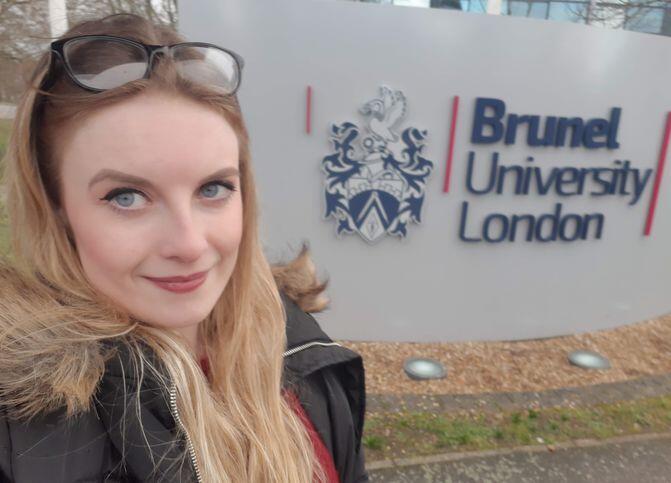My name is Kathryn Coldham and I am a PhD student from Brunel University London. I am currently based at CERN, the European Organisation for Nuclear Research. Situated near Geneva in Switzerland, CERN has been the birthplace of many discoveries and inventions, such as the World Wide Web, touchscreen technology and the Higgs boson, the particle that provides other particles with their masses. It is also home to the largest particle accelerator in the world: the Large Hadron Collider (LHC).
Buried 100 metres underground, the LHC is 27 kilometres in circumference and collides two counter-rotating beams of protons at nearly the speed of light! This gives rise to the most energetic collisions of any particle accelerator in the world and the remnants of the collisions are detected using a detector at each collision point. The detectors are ALICE, ATLAS, CMS and LHCb.
I work on the CMS experiment, which stands for 'Compact Muon Solenoid'. Where does it get its name from?
'Compact' because it contains 14,000 tonnes of material despite being 15 metres high and 21 metres long.
It detects many particles but is designed to detect type of particle called a 'muon' very accurately, which is a heavier cousin of the electron.
Finally, it contains a solenoid magnet which produces a magnetic field with a strength over 100,000 times that of the Earth’s – making it the most powerful magnet ever made! The magnet is used to bend the paths of the charged particles until they are absorbed and detected.
Working with my colleagues who are based at Brunel, my job as a PhD student is to analyse some of the data that has been taken by CMS. A person would typically embark on a PhD after having completed their bachelor’s or master’s and, in the UK, a full-time PhD can take three or four years to complete.
Last year I completed my MSci, a qualification equivalent to a master’s degree, in physics at Queen Mary University of London. I then began my PhD at Brunel in the Autumn, which is funded by the Science and Technology Facilities Council (STFC), working with the lovely High Energy Physics research group at Brunel.
Students funded by the STFC can spend a period of time working on the site of their experiment, which is why I will be based at CERN for a year and a half of my PhD.

Why are me and my colleagues analysing data taken by CMS? To search for one of the ways that a heavy particle, called the top quark, is predicted to be produced.
Quarks are a type of elementary particle, i.e. a particle that cannot be broken down any further. The other groups of elementary particles are leptons, which includes the electron, and gauge bosons, which transport the fundamental forces between the elementary particles.
But the top quark is special. With a mass around 170 times heavier than that of the proton, it is the heaviest of the known elementary particles. Its heavy mass leads to it decaying very quickly – in less than a millionth of a millionth of a millionth of a millionth of a second! – so, unlike the other elementary particles, the top quark does not undergo a process known as 'hadronisation'.
Hadronisation is when a quark produces a cone of other particles, called a 'jet'. Since the top quark does not do this, it can instead pass on information about its spin – a form of angular momentum – onto the particles that it decays into. This enables physicists to learn more about properties of the top quark that depend on its spin, providing further tests of the Standard Model (SM).
The SM is used to describe all of the known elementary particles and the interactions between them, so it is of interest to test it by making experimental observations to compare with SM predictions.
The top quark production mechanism that my colleagues and I are searching for is known in physics jargon as 'tZq production in association with a Z boson in the dilepton final state'. This way of producing a top quark is predicted by the SM, so observing this mechanism would further suggest that the SM correctly explains how elementary particles interact.
A typical day at CERN would begin with me heading to my office, which is inside a building that is shaped like a letter H (for the Higgs boson!).
The journey to my office would be via various roads on the CERN site, each named after a famous physicist. My day would then comprise me using code, statistical techniques and algorithms to implement the various stages that are required in the search for a physics process.
I also have regular Skype meetings with my colleagues back at Brunel and with colleagues who work on various top quark analyses in the CMS collaboration. Additionally, my work involves me attending conferences and workshops.
Conferences and workshops enable physicists to meet others working in the field, to learn more about the research others are carrying out and to learn about techniques that they could use in their own analyses.
So far during my PhD, I have attended the CMS data analysis school in Pisa, the Institute of Physics’ joint High Energy Physics and Astrophysics conference in London and CMS UK in Abingdon.
I also work in outreach, which includes my voluntary work editing physics articles with the CMS communications team and giving talks to school students and members of the public. But I do not work all of the time! For example, I am a member of the CERN taekwondo club, which I enjoy immensely. I also go hiking with friends in the mountains that surround the area, and swim in the beautiful Lake Geneva.
Working at CERN is phenomenal. Every day I meet and work with people from around the world and contribute to cutting-edge research. If you are interested in finding out more about PhDs or careers at CERN, check out the links below.